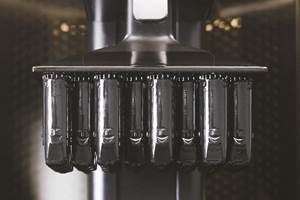PolySpectra Reformulates Rugged Resin for Desktop 3D Printers
COR Alpha was previously available solely for use on 385-nm wavelength 3D printers, limiting use to industrial hardware. The new formulation expands availability to 405-nm wavelength systems.
Share
Read Next
COR Alpha resin is now available in 405-nm wavelength formulation, which is suitable for desktop 3D printers. Photo Credit: polySpectra
PolySpectra, maker of rugged photopolymer resins, has created a new formulation of its flagship material that is compatible with desktop digital light processing (DLP) and liquid crystal display (LCD) resin 3D printers. Previously available solely for use on 385-nm wavelength 3D printers, limiting use to industrial hardware, the new formulation expands availability to 405-nm wavelength systems for additive manufacturing.
“We founded polySpectra with a mission to democratize manufacturing,” says Raymond Weitekamp, PhD., polySpectra founder and CEO. “Today, we are very excited to announce the 405-nm version of COR Alpha – which now gives engineers the ability to access the world's most rugged photopolymers on a wide array of resin 3D printers spanning every price point.
Real End-Use 3D Printing
While many “production-grade” resins available today for 3D printing can create high-resolution parts with unique geometric complexity, the company says they are often too brittle for demanding real-world applications. This inherently limits their use to prototyping and other less-demanding use cases.
COR stands for “Cyclic Olefin Resin,” a family of engineering-grade materials for AM developed by polySpectra. COR Alpha relies on Nobel-winning chemistry to offer durability, high-impact strength, high-temperature performance, and moisture- and chemical-resistant capabilities — all without brittleness. Satellite components, consumer products, electronics connectors and highly durable tooling for injection molding are just a few of the high-value applications where the company says COR Alpha can tip the scale from prototyping to production.
COR Alpha has been commercially available since 2022 in a 385-nm wavelength version which is compatible with and validated on a catalog of industrial-grade 3D printers.
This new formulation makes rugged AM more accessible. It is said the COR Alpha resin 405-nm formulation dramatically expands the list of compatible 3D printers. For the first time, inexpensive desktop 3D printers will have the capability to print with truly rugged resin. R&D labs, small businesses without industrial budgets and other users — many who already own desktop 3D printers — now gain the ability to create end-use parts in-house.
“The only difference between a toy and a tool is what it can produce,” Weitekamp says. “Whether you are running a $250 LCD printer or a $250,000 DLP machine, COR Alpha unlocks a step change in ROI.”
As of launch, 405-nm COR Alpha is fully validated for use on Asiga 3D printers. Additionally, many of the bestselling desktop 3D printer models are on the list of polySpectra’s exploratory 3D printers, including systems from Anycubic, Elegoo, Nexa3D, Phrozen, and Shining3D.
Over the next few weeks, polySpectra will announce validated print profiles for COR Alpha for many specific 3D printer models, in collaboration with these hardware manufacturers and others.
- Read how polySpectra is embracing augmented reality (AR) with a new tool called Massless intended to reduce unnecessary 3D printing.
- Listen to this episode of AM Radio to hear about parts printed from polySpectra COR resin and other odd-looking parts created using Metafold 3D software.
Related Content
AM 101: Digital Light Synthesis (DLS)
Digital Light Synthesis (DLS) is the name for Carbon's resin-based 3D printing process. How it works and how it differs from stereolithography.
Read MoreWhat is Powder Bed Fusion 3D Printing?
Whether in metal or polymer, with a laser or an electron beam, powder bed fusion (PBF) is one of the most widely used 3D printing techniques.
Read MoreLarge-Format “Cold” 3D Printing With Polypropylene and Polyethylene
Israeli startup Largix has developed a production solution that can 3D print PP and PE without melting them. Its first test? Custom tanks for chemical storage.
Read More8 Cool Parts From RAPID+TCT 2022: The Cool Parts Show #46
AM parts for applications from automotive to aircraft to furniture, in materials including ceramic, foam, metal and copper-coated polymer.
Read MoreRead Next
At General Atomics, Do Unmanned Aerial Systems Reveal the Future of Aircraft Manufacturing?
The maker of the Predator and SkyGuardian remote aircraft can implement additive manufacturing more rapidly and widely than the makers of other types of planes. The role of 3D printing in current and future UAS components hints at how far AM can go to save cost and time in aircraft production and design.
Read More4 Ways the Education and Training Challenge Is Different for Additive Manufacturing
The advance of additive manufacturing means we need more professionals educated in AM technology.
Read MoreHybrid Additive Manufacturing Machine Tools Continue to Make Gains (Includes Video)
The hybrid machine tool is an idea that continues to advance. Two important developments of recent years expand the possibilities for this platform.
Read More









.png;maxWidth=300;quality=90)














